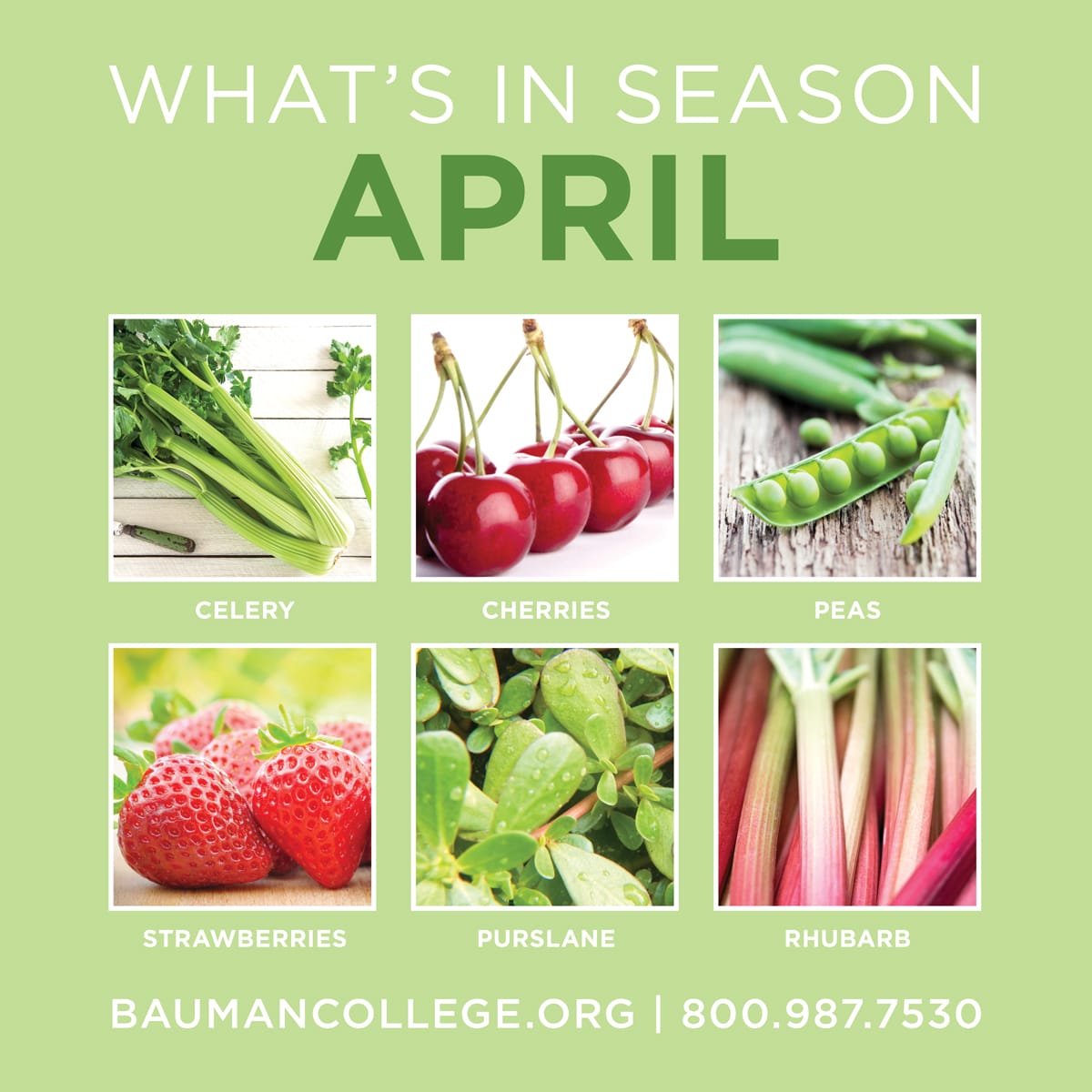Farm to Fork
This month, we’re focusing on spring produce, where to find it, and how to use it! Enjoy the guide below, get to know your local farmers at the Ferry Plaza Farmers Market in San Francisco, and keep an eye out for seasonal recipes this month on the Bauman College blog and social media!

Celery
Celery is a versatile member of the carrot family and the cornerstone of many culinary staples, from mirepoix to sofrito (CUESA, 2017). It is high in organic (i.e. plant-based) sodium—a healthy and important nutrient for cardiovascular health and acid-alkaline balance. The whole plant is edible—the root (also known as celeriac) can be roasted or puréed, the stalks and leaves can be added to salads or stews, and the seeds can be used as a spice. It is important to choose organically grown celery because commercially grown celery is sprayed heavily with chemical pesticides (Wood, 2010). Find local North Marin County-grown celery at the Allstar Organics stand at the market on Saturdays (CUESA, 2017).
Cherries
Cherries are a member of the prune family and can be sweet or sour (Wood, 2010). They contain anti-inflammatory and antioxidant compounds—such as carotenes and quercetin. A member of the EPA’s “Dirty Dozen” list, it is important to search for organic cherries that are bright, plump, and soft (Wood, 2010). Hamada Farms grows 20 different varieties of cherries in the Central Valley and can be found at the market on Tuesdays and Saturdays (CUESA, 2017).
Peas
Peas are a cold-weather crop that are usually available only in the spring, but can be purchased throughout the year, thanks to Iacopi Farms located in Half Moon Bay (Wood, 2010; CUESA, 2017). They support proper blood sugar balance, are a good source of plant-based protein and fiber, and are low in calories. It is important to find freshly picked pea pods that are crisp and shiny (Wood, 2010).
Purslane
Considered an edible herb or weed, purslane contains the highest amount of omega-3 fatty acids of any vegetable—one cup contains 400 mg of alpha-linolenic acid (ALA), which helps lower triglyceride levels in the blood (Wood, 2010). It is also rich in B vitamins, which support the nervous system and metabolism. The slightly sour taste adds a little bite to a salad, and can also be used in a tea or tinctures (Wood, 2010). It grows wild in the United States, but is also sold by Four Sisters Farm at the market on Saturdays (CUESA, 2017).
Rhubarb
Rhubarb is classified as a vegetable, though it is often used as a fruit, and has characteristic long, pale green or red stalks and green leaves (CUESA, 2017). Its leaves are toxic due to high levels of oxalic acid and glycosides and are not safe for human consumption. The stems are often combined with seasonal fruits, such as strawberries, and made into pies and jams (Wood, 2010). Rhubarb is a great source of phytonutrients—such as carotenes, lutein, and zeaxanthin—and contains antioxidant and anti-inflammatory properties that support healthy function of many organs and tissues. Look for firm, crisp stalks from Happy Quail Farms at the market on Tuesdays and Saturdays (CUESA, 2017).
Strawberries
A member of the rose family (together with other berries, apples, and almonds), strawberries are high in vitamin C and antioxidants, such as lutein and beta-carotene, which support eye health. Yet another member of the EPA’s “Dirty Dozen”, it is important to use organic strawberries to avoid pesticides. According to CUESA.org (2017), “Farms that grow strawberries without chemical fertilizers in rich, healthy soils claim their berries develop more complex flavors.” Look for fully red, unblemished, fragrant, organic strawberries from Swanton Berry Farm at the market on Saturdays (Wood, 2010; CUESA, 2017).
RESOURCES
Environmental Working Group. (n.d.). Dirty dozen: EWG’s 2017 shopper’s guide to pesticides in produce™. Retrieved 4/5/2017 from https://www.ewg.org/foodnews/dirty_dozen_list.php
PickYourOwn.org. (n.d.). Harvest calendar for CA. Retrieved 3/28/17 from http://www.pickyourown.org
Seasonality Charts. (n.d.). Retrieved 3/28/17, from http://www.cuesa.org/eat-seasonally/charts
Wood, R. T. (2010). The new whole foods encyclopedia: a comprehensive resource for healthy eating. (pp. 70, 75, 264–265, 290, 299, 343). New York, NY: Penguin Books.